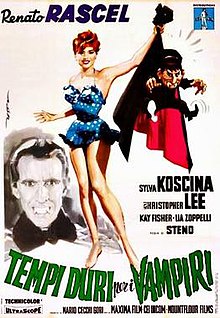Uncle Was a Vampire
| Uncle Was a Vampire | |
|---|---|
 Italian film poster for Uncle Was a Vampire | |
| Directed by | Steno |
| Screenplay by | |
| Story by |
|
| Produced by | Mario Cecchi Gori[1] |
| Starring |
|
| Cinematography | Marco Scarpelli[2] |
| Edited by | Eraldo Da Roma[2] |
| Music by | |
Production companies |
|
| Distributed by | C.E.I.-Incom |
Release date |
|
Running time | 90 minutes |
| Country | Italy[1] |
| Box office | ₤385 million |
Uncle Was a Vampire (Italian: Tempi duri per i vampiri) is a 1959 Italian film directed by Steno.[2]
Plot
Baron Osvaldo Lambertenghi is forced to sell his ancestral castle for debts. The manor is ingloriously transformed into a frivolous hotel and Osvaldo is allowed to continue to live there working as a porter. One day Osvaldo receives a visit from his uncle Roderico, who turns out to be a real vampire. Osvaldo tries to warn of what the various guests of the hotel, with the only result of being taken for a madman. Bitten by his uncle, Oswald will also turn into a vampire, but his beloved Lellina will be able to free him from the curse.
Cast
- Renato Rascel: Baron Osvaldo Lambertenghi
- Christopher Lee: Baron Roderico da Frankurten
- Sylva Koscina: Carla
- Kai Fischer: Lellina
- Lia Zoppelli: Letizia
- Franco Scandurra: Professor Stricker
- Carl Wery: Director
- Rik Van Nutter: Fianceè of Carla
- Susanne Loret: Susan
- Mario Cecchi Gori: Civil-law notary
- Franco Giacobini
Production
Uncle Was a Vampire was Christopher Lee's first entry into an Italian film production.[3]
Bruno Martino's song "Dracula cha-cha" is played over the credits of the film.
Release
Uncle Was a Vampire was released in Italy on October 28, 1959 where it was distributed by C.E.I.-Incom. It grossed a total of 385 million lire in Italy. The film was Italy first vampire film. The film was released in the USA in 1964 on television through Embassy Pictures Television[1]
Reception
In his book Italian Horror Film Directors, Louis Paul described the film as "obviously modeled on the slapstick efforts of the comedies featuring the character Toto".[4]
Notes
References
- Curti, Roberto (2015). Italian Gothic Horror Films, 1957-1969. McFarland. ISBN 1476619891.
{{cite book}}: Invalid|ref=harv(help) - Paul, Louis (2005). Italian Horror Film Directors. McFarland. ISBN 978-0-7864-8749-3.
{{cite book}}: Invalid|ref=harv(help)
External links
